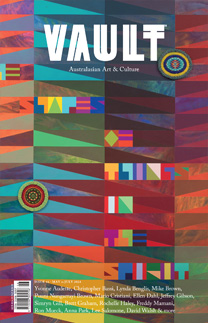Brook Andrew
Civil Liberties
Spanning sculpture, video, photography and immersive installation, the output of Australian artist Brook Andrew is less interested in preserving cultural niceties than it is in creating an alternative lens for viewing the world.
“I was very lucky to study at the University of Western Sydney in the early 1990s,” Brook Andrew tells me, at the conclusion of his floor talk at the National Gallery of Victoria in Melbourne’s Federation Square. “There were some incredible staff teaching there at that time – Anne Graham, Janet Lawrence, Eugenia Raskopoulos, and Vivien Johnson. Chris Fortescue was a particularly strong influence on me and really encouraged me to make White word I.” The exhibition and catalogue contains this work, as it does many other pivotal pieces, and The Right to Offend is Sacred can be seen as a visual memoir linking the always-inquisitive young art student to the mature, confident, artist and thinker. The trajectory continues.
One gallery is like a hall of neon, while in another, giant Indigenous portraits are printed on canvas so large that they echo the scale and ambition of an Anselm Kiefer or Julian Schnabel. There are inflatable sculptures and thought-provoking wall-texts-as-art. Doubles stare out at you, catching reflections from the nearby neon, as in 1997’s I split your gaze, a large gelatin silver photograph. Strange shapes appear in the negative space between the two profiles, like a duck/rabbit visual conundrum. Is it a candlestick holder or a phallus?
During the floor talk, which drew a large audience for early on a Saturday and included Andrew’s parents, I felt like I was in a post-modern stage set for Hamlet. I am seated in the front row and Andrew is straight ahead of me. Just above his shoulder a small skull... Subscribe to read this article in full
























